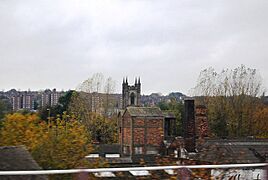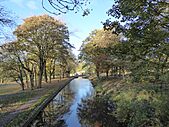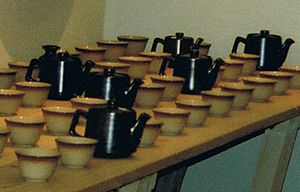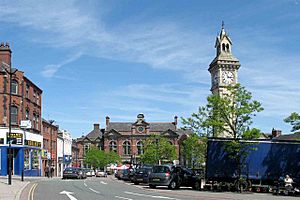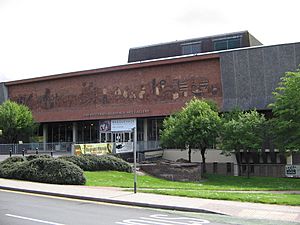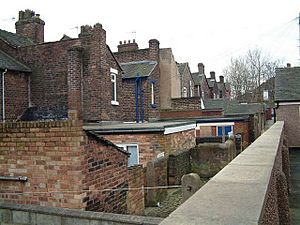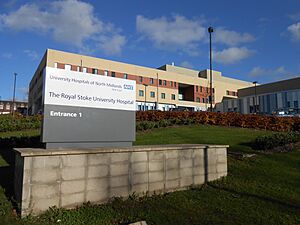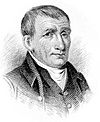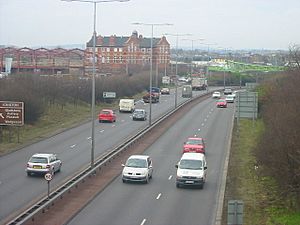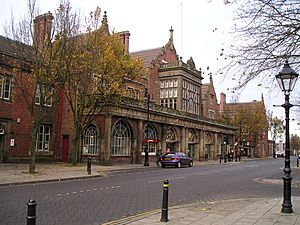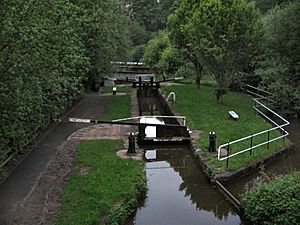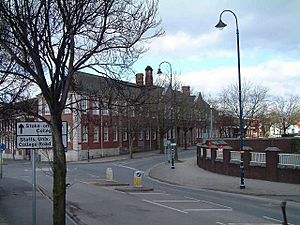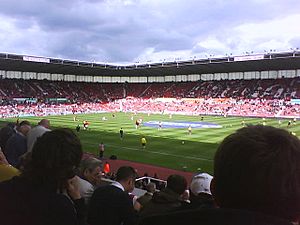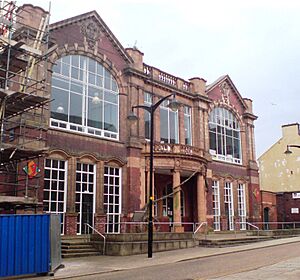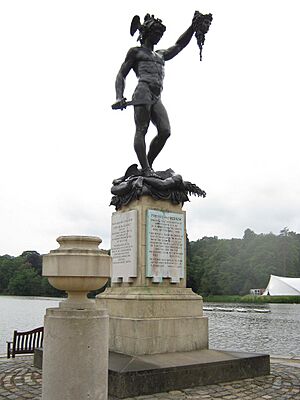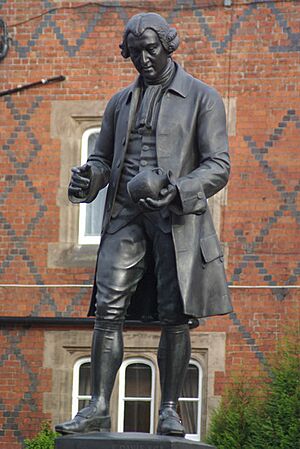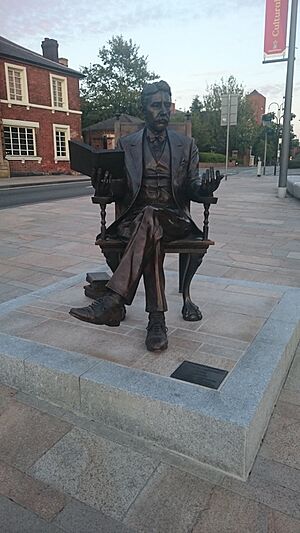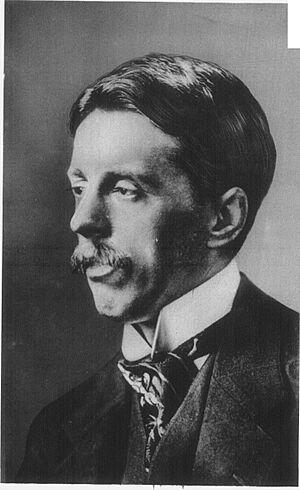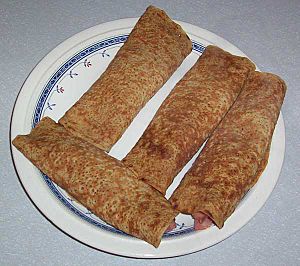Stoke-on-Trent facts for kids
Quick facts for kids
Stoke-on-Trent
Stoke |
|
|---|---|
|
City and Unitary authority
|
|
|
|
| Nickname(s):
The Potteries, City of the Six Towns, Stoke and Stokie
|
|
| Motto(s):
Vis Unita Fortior (united strength is stronger)
|
|
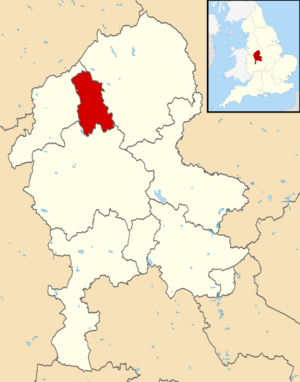
Shown within Staffordshire
|
|
| Sovereign state | United Kingdom |
| Country | England |
| Region | West Midlands |
| Ceremonial county | Staffordshire |
| County Borough established (Burslem, Fenton, Hanley, Longton, Stoke-upon-Trent and Tunstall) | 31 March 1910 |
| City status | 5 June 1925 |
| Unitary authority | 1 April 1998 |
| Administrative HQ | Hanley & Stoke-upon-Trent |
| Areas of the city (2011 census BUASD) |
List
Abbey Hulton
Baddeley Green Bentilee Berryhill Fields Birches Head Blurton Bucknall Burslem (One of the Six Towns) Chell Cliffe Vale Cobridge Dresden Etruria Fenton (One of the Six Towns) Florence Goldenhill Hanford Hanley (One of the Six Towns) Hartshill Hem Heath Heron Cross Lightwood Longport Longton (One of the Six Towns) Meir Meir Heath (Village) Middleport Milton Normacot Northwood Norton le Moors (Part) Penkhull Shelton Sideway Smallthorne Sneyd Green Stoke-upon-Trent (One of the Six Towns) Trentham Tunstall (One of the Six Towns) Weston Coyney |
| Government | |
| • Type | Unitary authority with leader and cabinet |
| • Body | Stoke-on-Trent City Council |
| Area rank | 246th |
| Population
(2005 est.)
|
|
| • Total | 259,965 |
| • Rank | 68th |
| Demonym(s) | Stokie |
| Ethnicity (2021) | |
| • Ethnic groups |
List
|
| Religion (2021) | |
| • Religion |
List
60.9% Christianity
25.2% no religion 6.0% Islam 0.6% Hinduism 0.4% other 0.3% Buddhism 0.2% Sikhism 0.1% Judaism 6.4% not stated |
| Time zone | UTC+0 (GMT) |
| • Summer (DST) | UTC+1 (BST) |
| Postcode area |
ST1-4, 6-9, 12
|
| Dialling code | 01782 |
| ISO 3166 code | GB-STE |
| GSS code | E06000021 |
| ITL code | UKG23 |
| • Total | £7.5 billion |
| • Per capita | £28,627 |
Stoke-on-Trent (often called Stoke) is a city in Staffordshire, England. It covers about 36 square miles (93 km²) and had around 259,965 people in 2022. It is the biggest city in Staffordshire. Stoke-on-Trent is surrounded by towns like Newcastle-under-Lyme, Alsager, Kidsgrove, and Biddulph. Together, these towns form a large urban area.
The city is unique because it was formed in 1910 by joining six towns. It got its name from Stoke-upon-Trent, where the main government offices and train station were. Hanley is the main shopping and business area. The other four towns that make up the city are Burslem, Tunstall, Longton, and Fenton.
Stoke-on-Trent is famous as the home of the pottery industry in England. It is known as The Potteries. Today, it is a hub for service industries and distribution centers. In the past, it was known for heavy industries like mining and steel.
Contents
- History of Stoke-on-Trent
- Geography of Stoke-on-Trent
- People of Stoke-on-Trent
- Places to Visit in Stoke-on-Trent
- Stoke-on-Trent's Economy
- Public Services
- Religion in Stoke-on-Trent
- Getting Around Stoke-on-Trent
- Education in Stoke-on-Trent
- Sports in Stoke-on-Trent
- Culture and Arts in Stoke-on-Trent
- Stoke-on-Trent Dialect
- International Friends
- Images for kids
- See also
History of Stoke-on-Trent
What's in a Name?
The name Stoke comes from the old town of Stoke-upon-Trent. Stoke is an old English word that meant "place." It could mean a dairy farm, a crossing point, or a place of worship. No one is sure which meaning was intended here. A church is said to have been founded in Stoke in 670 AD. Because "Stoke" was a common name, "on-Trent" was added to show it was by the River Trent.
The city's motto is Vis Unita Fortior. This means "United Strength is Stronger."
How the Six Towns Became One City
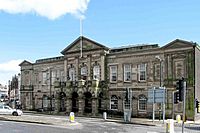
In 1910, the six towns of Burslem, Fenton, Hanley, Longton, Stoke, and Tunstall joined together. They became one large area called the County Borough of Stoke-on-Trent. This was a big step for the region.
In 1925, Stoke-on-Trent was officially given "city status" by King George V. This made it a more important place in the country. The city has grown over the years, adding nearby areas. Today, it is a unitary authority, which means it runs its own local government.
Stoke's Main Industries
The Pottery Industry
Since the 1600s, Stoke-on-Trent has been famous for making pottery. Companies like Royal Doulton, Spode, and Wedgwood started here. The area had lots of coal and clay, which were perfect for making pottery.
The Trent and Mersey Canal, finished in 1777, helped bring in special clay from Cornwall. This allowed potters to make even finer items like bone china. Famous potters like Josiah Wedgwood helped the industry grow. He built his Etruria Works in 1766. Many talented artists like Clarice Cliff and Susie Cooper also came from Stoke-on-Trent.
Coal Mining
North Staffordshire was also a major coal mining area. People started mining coal here in the 1200s. By 1947, about 20,000 men worked in the mines in Stoke-on-Trent.
Some mines in Stoke set national records. Wolstanton Colliery had the deepest shafts in Europe. In 1933, Chatterley Whitfield Colliery was the first in the country to mine one million tons of coal. However, all the mines closed by 1994.
Today, the old mine sites are covered with plants and animals. Chatterley Whitfield became a museum for a while and is now a local nature reserve. The underground mines are closed, but they can still cause small tremors. There's a campaign to make the North Staffordshire Coalfield a World Heritage Site because of its important history.
Steel Production
The iron and steel industries were also very important to Stoke-on-Trent. The Shelton Steelworks made steel until 1978. The rolling plant, which shaped steel, closed in 2002.
During World War II, Shelton Steel Works and the mines helped with the war effort. The famous Supermarine Spitfire plane was designed by Reginald Mitchell, who trained at a railway works in Stoke.
Other Industries
The Michelin tyre company built its first UK factory in Stoke-on-Trent in the 1920s. Today, it still has a presence in the city. Other major companies like Bet365 (an online gambling company) and Sainsbury's (a supermarket) have large operations here.
Geography of Stoke-on-Trent
Stoke-on-Trent is located between Manchester and Birmingham. It is next to Newcastle-under-Lyme, which is a separate town. The city sits in the upper valley of the River Trent. It is at the southern end of the Pennines hills.
Stoke-on-Trent is often called "the city of five towns" by local writer Arnold Bennett. He left out Fenton, which was the smallest town. It is the only "polycentric" city in the UK, meaning it has many centers instead of just one.
The six towns run in a line from north to south along the A50 road. They are Tunstall, Burslem, Hanley, Stoke, Fenton, and Longton. Even though the city is named after Stoke, Hanley is seen as the main city center for shopping and business.
City Neighborhoods
Besides the six main towns, Stoke-on-Trent has many neighborhoods. Some of these include Bentilee, Goldenhill, Meir, Penkhull, and Trentham.
Stoke's Climate
Stoke-on-Trent has a mild, wet climate like the rest of the UK. Because it's near the Pennines, it can be cooler than nearby flat areas. The average temperature in July is about 20.3°C (68.5°F). The coldest month is January, with an average of 3.7°C (38.7°F). The city gets about 806 mm of rain each year.
| Climate data for Stoke on Trent / Keele, elevation: 179m, (1981–2010) extremes (1960–present) | |||||||||||||
|---|---|---|---|---|---|---|---|---|---|---|---|---|---|
| Month | Jan | Feb | Mar | Apr | May | Jun | Jul | Aug | Sep | Oct | Nov | Dec | Year |
| Record high °C (°F) | 13.3 (55.9) |
15.4 (59.7) |
20.6 (69.1) |
23.7 (74.7) |
25.9 (78.6) |
30.0 (86.0) |
31.3 (88.3) |
32.9 (91.2) |
26.5 (79.7) |
26.8 (80.2) |
17.3 (63.1) |
14.4 (57.9) |
32.9 (91.2) |
| Mean daily maximum °C (°F) | 6.2 (43.2) |
6.6 (43.9) |
9.1 (48.4) |
11.8 (53.2) |
15.1 (59.2) |
17.7 (63.9) |
20.3 (68.5) |
19.7 (67.5) |
16.9 (62.4) |
13.0 (55.4) |
9.0 (48.2) |
6.4 (43.5) |
12.6 (54.7) |
| Daily mean °C (°F) | 3.7 (38.7) |
3.8 (38.8) |
5.9 (42.6) |
7.9 (46.2) |
11.0 (51.8) |
13.7 (56.7) |
15.8 (60.4) |
15.7 (60.3) |
13.3 (55.9) |
9.9 (49.8) |
6.5 (43.7) |
3.9 (39.0) |
9.3 (48.7) |
| Mean daily minimum °C (°F) | 1.1 (34.0) |
0.9 (33.6) |
2.6 (36.7) |
4.0 (39.2) |
6.9 (44.4) |
9.6 (49.3) |
11.7 (53.1) |
11.6 (52.9) |
9.7 (49.5) |
6.8 (44.2) |
3.7 (38.7) |
1.4 (34.5) |
5.9 (42.6) |
| Record low °C (°F) | −13.3 (8.1) |
−10.0 (14.0) |
−9.4 (15.1) |
−4.7 (23.5) |
−2.8 (27.0) |
1.4 (34.5) |
5.0 (41.0) |
4.6 (40.3) |
1.1 (34.0) |
−2.5 (27.5) |
−7.0 (19.4) |
−12.5 (9.5) |
−13.3 (8.1) |
| Average precipitation mm (inches) | 67.9 (2.67) |
48.3 (1.90) |
58.5 (2.30) |
58.0 (2.28) |
62.7 (2.47) |
67.3 (2.65) |
62.1 (2.44) |
75.4 (2.97) |
69.1 (2.72) |
82.7 (3.26) |
76.7 (3.02) |
77.4 (3.05) |
806.1 (31.74) |
| Average precipitation days (≥ 1.0 mm) | 13.2 | 10.4 | 13.0 | 11.6 | 10.8 | 11.0 | 11.3 | 11.6 | 10.6 | 13.4 | 13.5 | 13.4 | 143.6 |
| Mean monthly sunshine hours | 52.6 | 71.7 | 100.4 | 143.9 | 182.0 | 159.4 | 178.5 | 167.1 | 123.4 | 100.2 | 58.1 | 45.5 | 1,382.9 |
| Source 1: KNMI | |||||||||||||
| Source 2: Met Office | |||||||||||||
People of Stoke-on-Trent
In 2011, Stoke-on-Trent had a population of 249,008. Most people (91.68%) were born in the UK. About 86.43% of the people identified as White British. Other groups included British Pakistani (4.19%) and Other White (1.88%).
Most people (60.89%) in Stoke-on-Trent are Christian. About 25.19% said they had no religion. A smaller number (6.02%) are Muslim.
Places to Visit in Stoke-on-Trent
The city has many interesting places to visit, especially those related to its pottery history.
- The Potteries Museum & Art Gallery in Hanley has a large collection of ceramics. It also shows the famous Staffordshire Hoard of Anglo-Saxon gold.
- The Gladstone Pottery Museum in Longton is an old pottery factory you can explore.
- Many pottery companies have shops and visitor centers. These include Wedgwood in Barlaston and Emma Bridgewater in Hanley.
- Burleigh Pottery in Middleport is the oldest working Victorian pottery in the world.
- Stoke Minster in Stoke-upon-Trent is the city's main church.
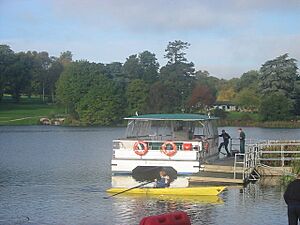
- Trentham Gardens is just south of the city. It's a beautiful place with gardens and a lake.
- Next to Trentham Gardens is Trentham Monkey Forest. Here, you can walk among 140 Barbary macaque monkeys.
- Alton Towers Resort, a famous theme park, is about 10 miles (16 km) east of Stoke-on-Trent.
- Waterworld is an indoor swimming complex near Hanley.
Stoke-on-Trent also has many parks. Burslem Park is one of the largest Victorian parks in the UK. Park Hall Country Park is a nature reserve with sandstone canyons. Westport Lake is the city's largest body of water and has a nature reserve.
Stoke-on-Trent's Economy
Stoke-on-Trent was once the world center for fine ceramics. In the late 1980s and 1990s, many factories, steelworks, and mines closed. This caused a rise in unemployment.
Today, pottery firms like Wedgwood and Portmeirion are still based here. Other companies like Bet365 (an online betting company) and Michelin (tyres) also have a strong presence. Sainsbury's and The Co-operative Pharmacy have large warehouses in the city.
Stoke City Football Club is a major symbol of the city. It brings many visitors and jobs. The club moved to the Bet365 Stadium in 1997. This helped to start new developments in the Trentham area, including the regeneration of Trentham Gardens.
The Potteries Shopping Centre in Hanley is the main shopping area. It has many stores and restaurants. The city is known for having affordable business properties. It also has good road and rail links, making it a good place for businesses.
Public Services
The main hospital in Stoke-on-Trent is the Royal Stoke University Hospital. It is one of the biggest hospitals in the UK. Staffordshire Police provides policing services, with stations in several towns across the city. The Staffordshire Fire and Rescue Service provides fire and rescue services.
The city's main library was the City Central Library in Hanley. In 2022, it was announced that the library would close. The city's historical archives are moving to the Potteries Museum & Art Gallery.
Religion in Stoke-on-Trent
Stoke-on-Trent does not have a cathedral. However, Stoke Minster is the city's main Church of England church. The city is part of the Roman Catholic Archdiocese of Birmingham.
Primitive Methodism was started by Hugh Bourne, who was from Stoke-on-Trent. He began holding outdoor services and founded the first chapel in Tunstall in 1811. He believed in equal treatment for women and men.
The city has mosques, and there are two Sikh temples. The city's only synagogue closed in 2006, but a smaller one opened in nearby Newcastle-under-Lyme.
Getting Around Stoke-on-Trent
Major Roads
Stoke-on-Trent is connected to the M6 motorway by the A500 road. The A500 is often called the D road because of its shape. The A50 connects the city to the M1 motorway. These roads help businesses move goods around easily.
Train Travel
Stoke-on-Trent railway station is on the main line between Stafford and Manchester. There are also smaller stations at Longport and Longton.
Bus Services
Buses are the main way to get around the city. First Potteries operates most bus services. There are central bus stations in Hanley and Longton. You can also catch long-distance coaches from Hanley bus station.
Canals
The Trent and Mersey Canal runs through the city. The Caldon Canal also branches off from it in Etruria. These canals are used by many boats each year.
Cycling
Stoke-on-Trent has over 77 miles (124 km) of off-road bicycle paths. These paths are part of the National Cycle Network. They connect to longer paths across the country.
Education in Stoke-on-Trent
Colleges and Universities
Stoke-on-Trent has two main colleges: City of Stoke-on-Trent Sixth Form College and Stoke-on-Trent College. The Sixth Form College helps students prepare for university. Stoke-on-Trent College offers apprenticeships and adult education.
The city is home to Staffordshire University. It became a university in 1992. Keele University is also nearby and uses facilities at the Royal Stoke University Hospital.
High Schools
The city has 15 secondary schools. Some of these include Birches Head Academy, Discovery Academy, and St Joseph's College. In 2007, some schools merged to create new academies.
Potters' Holidays
In the past, Stoke-on-Trent had special "Potters' Holidays" or "Potters' Fortnight." These were two-week breaks in June and July, plus another week in August. This meant unusual school holidays for children. These special holidays are no longer observed in local schools.
Sports in Stoke-on-Trent
Football Teams
Stoke-on-Trent is one of the smallest cities in England to have two professional football clubs.
- Stoke City was formed in 1863. It is the second-oldest professional football club in England. They play at the Bet365 Stadium. Stoke City won their only major trophy, the League Cup, in 1972. They reached the FA Cup final in 2011.
- The city's most famous player is Sir Stanley Matthews. He played for Stoke City and was the first footballer to be knighted. There are two statues of him in the city.
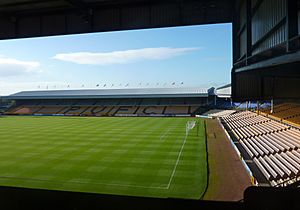
- Port Vale was formed in 1876. They play at Vale Park in Burslem. They have never played in the top division of English football.
Other Sports
Stoke-on-Trent has many amateur sports clubs, including rugby union and cricket. The city's speedway team is the Stoke Potters.
Famous Athletes
The city has a Sporting Hall of Fame. Stanley Matthews and darts world champion Phil Taylor were among the first to be honored. Other famous athletes from Stoke include:
- Adrian Lewis and Ted Hankey (darts players)
- Angela Smith (squash player)
- Bob Taylor (cricketer)
- Eddie Hall (professional strongman)
Culture and Arts in Stoke-on-Trent
Architecture and Buildings
Stoke-on-Trent's buildings show its industrial past. You can see old bottle ovens (used for pottery), canal-side factories, and railway buildings. The Potteries Museum and Art Gallery is a good example of modern civic architecture.
Science and Innovation
Several important scientists were born in Stoke-on-Trent:
- Oliver Lodge (1851–1940) was a physicist who helped develop radio.
- William Astbury (1898–1962) studied biological molecules using X-rays.
Art and Galleries
The main art gallery is The Potteries Museum & Art Gallery in Hanley. It has a great collection of ceramics and other art. The city's Cultural Quarter in Hanley also has the Regent Theatre and the Victoria Hall.
Public Artworks
Stoke-on-Trent has many public sculptures:
- Perseus with the Head of Medusa at Trentham Gardens is a copy of a famous Italian sculpture.
- A statue of Josiah Wedgwood stands at Stoke-on-Trent railway station.
- The Spirit of Fire (also called The Man of Fire) is a sculpture on a building in Hanley.
- CAPO, a modern sculpture of Josiah Wedgwood, was unfortunately damaged in 2023.
- A Man Can't Fly is a sculpture near Stoke Station.
-
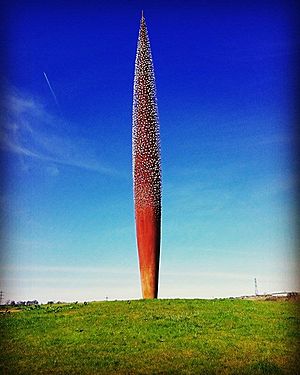 The Golden sculpture, March 2017.
The Golden sculpture, March 2017. - The Golden sculpture in Tunstall is a large steel artwork with lights.
- Unearthed (Lidice) is a steel sculpture near Hanley bus station. It remembers the efforts of miners to rebuild a Czech village after World War II.
- A statue of writer Arnold Bennett was unveiled in Hanley in 2017.
Theatre and Shows
The Regent Theatre in Hanley is the city's main theatre. The Victoria Hall is a concert hall. The New Vic Theatre is just outside the city in Newcastle-under-Lyme. The Mitchell Arts Centre is named after Reginald Mitchell, who designed the Spitfire plane.
Movies
Hanley has a new nine-screen Cineworld Cinema. There is also an Odeon cinema at Festival Park. The Stoke-on-Trent Film Theatre shows independent and art-house films.
Literature and Writers
Arnold Bennett is the city's most famous writer. He wrote novels about the "Six Towns," often calling them the "Five Towns." He changed the names of places in his books, like calling Hanley "Hanbridge."
Other writers from the area include John Wain (poet) and Charles Tomlinson (poet).
Music Scene
Stoke-on-Trent has a lively music scene. The Golden Torch nightclub was a center for "Northern soul" music in the 1970s. Shelley's Laserdome was important for house and rave music in the late 1980s.
Robbie Williams is the most famous pop star from Stoke-on-Trent. Many of his songs mention the city. Slash, the guitarist from Guns N' Roses, also grew up in Stoke-on-Trent.
Other musicians from the area include Lemmy (founder of Motörhead) and Jem Finer (from The Pogues).
Local Food
Staffordshire oatcakes are a special local food. They are different from Scottish oatcakes and are often eaten with sweet or savory fillings. Lobby, a stew similar to Lancashire hotpot, is another traditional local dish.
Stoke Pride
Stoke Pride is the city's yearly celebration of the LGBT community. It started in 2005 and attracts many visitors. It is held in Hanley Park.
Stoke-on-Trent Dialect
The Potteries has its own special local dialect. Some unique words include nesh (meaning easily cold) and slat (meaning to throw). The most famous word is duck, used as a friendly greeting to anyone.
Another common word is shug for sugar, often used as a term of endearment, like "Ta Shug" (thank you, sugar).
A local cartoon called May un Mar Lady (Me and my Wife) was written in the Potteries dialect. It appeared in The Sentinel newspaper for over 20 years.
International Friends
Stoke-on-Trent is twinned with:
- East Liverpool, Ohio, United States
- Erlangen, Bavaria, Germany (since 1989)
Images for kids
See also
 In Spanish: Stoke-on-Trent para niños
In Spanish: Stoke-on-Trent para niños


